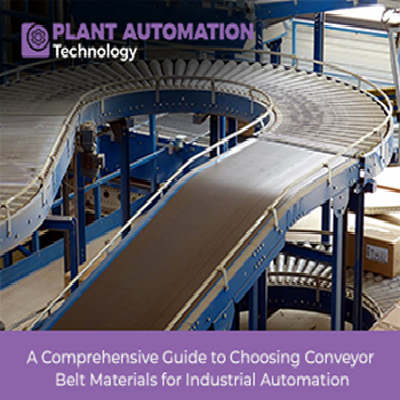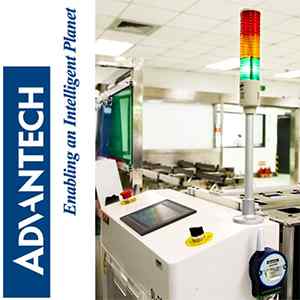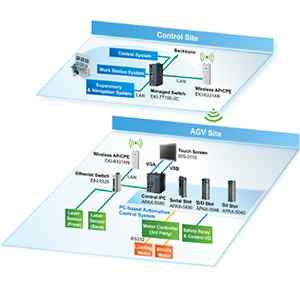A Comprehensive Guide to Choosing Conveyor Belt Materials for Industrial Automation

Introduction
Industrial automation uses conveyor belt systems to streamline operations and maximize efficiency. Selecting the appropriate conveyor belt material is essential to ensure smooth and reliable performance in various applications. This article explores different conveyor belt materials, their properties, and how they meet industrial automation demands.
| Also Read: Efficiency in Motion: Conveyors & Conveying Equipment for Streamlined Operations |
Industrial Conveyor Belt Materials
Industrial automation requires conveyor belt material. Different materials offer specific advantages and are suited to various applications. Here are some common conveyor belt materials:
- Rubber-based Materials:
Rubber-based conveyor belts are widely used in industrial automation due to their versatility and excellent grip. Natural rubber, synthetic rubber, and blends are popular options in this category. They offer high abrasion resistance and flexibility and can handle a wide range of loads. Rubber belts are ideal for applications such as general conveying, package handling, and incline/decline transportation.
- PVC and PU Materials:
Polyvinyl chloride (PVC) and polyurethane (PU) conveyor belts are known for their durability and resistance to chemicals and oils. These materials are suitable for hygiene applications, such as food processing, pharmaceutical industries, and cleanroom environments. PVC belts are cost-effective and offer excellent abrasion resistance, while PU belts provide enhanced flexibility and are ideal for conveying small or delicate products.
- Metal Materials:
Metal conveyor belts, typically made of stainless steel, are ideal for heavy-duty industrial automation. They excel in high-temperature environments, have superior strength, and resist corrosion. Metal belts are commonly used in applications such as heat treatment, foundries, and the automotive industries. They can handle heavy loads and provide excellent durability and longevity.
Specialty Conveyor Belt Materials
In addition to the commonly used materials mentioned earlier, there are specialty conveyor belt materials available for specific applications. These include:
- Anti-static Conveyor Belt Materials: Designed to dissipate electrostatic electricity and prevent static charges that can damage sensitive electronic components or cause explosions in certain industries.
- Heat-Resistant Conveyor Belt Materials: Constructed to withstand high temperatures, these materials are often used in applications involving hot products, heat treatment processes, or conveying in close proximity to heat sources.
- Flame-retardant Conveyor Belt Materials: Specifically engineered for fire-resistant properties, these materials are crucial in industries where fire safety is a concern, such as mining, power plants, or other hazardous environments.
- Oil-Resistant Conveyor Belt Materials: Engineered to withstand the detrimental impact of oil and other substances derived from petroleum, these materials are ideal for industries where oil contamination is prevalent, such as automotive or recycling facilities.
| Also Read: Innovations in Industrial Conveyor Belt Technology: Enhancing Safety and Performance |
Key Factors in Belt Material Selection
When choosing the right conveyor belt material for your industrial automation needs, several key factors should be considered:
1. Load and Application: Assess the weight, dimensions, and nature of the products being conveyed. Heavy loads may necessitate sturdy materials with excellent tensile strength, whereas fragile items may require softer surfaces to avoid potential harm. Take into account the particular demands of your application, such as oil resistance, flame retardancy, or anti-static properties.
2. Environmental conditions: Assess the operating environment where the conveyor system will be used. Consider temperature extremes, moisture levels, exposure to chemicals or oils, and other environmental factors. Some materials may be better suited to high-temperature environments, while others may offer superior chemical resistance. Choose a belt material that can withstand the specific conditions under which it will be utilized to ensure optimal performance and longevity.
3. Friction and Grip: The friction coefficient is crucial to prevent slippage or product movement during transportation. Different belt materials offer varying grip levels. For applications that require high grip, such as inclined conveyors or steep inclines, materials with textured surfaces or patterns may be beneficial. Evaluate the frictional properties of the belt material and choose one that provides the necessary grip for your specific application.
|
Also Read: Improving Supply Chain Efficiency: Conveyor Belt Manufacturers and Automation Solutions |
Conveyor Belt Material Maintenance and Care
Maximizing conveyor belt materials' lifespan and performance requires diligent maintenance and care. It is imperative to regularly inspect the belts for signs of wear, damage, or misalignment. Implementing cleaning protocols to remove debris, contaminants, or product residues that hinder belt performance is crucial. Additionally, following the manufacturer's guidelines for proper tensioning, tracking, and lubrication (if applicable) is essential for ensuring the optimal operation of the conveyor belt.
Environmental considerations
Sustainability and environmental impact are increasingly significant factors in material selection. Conveyor belt manufacturers are focusing on developing eco-friendly materials, such as recycled rubber or PVC materials with a reduced environmental footprint. Consideration should also be given to disposal or recycling options for conveyor belt materials at the end of their lifecycle.
| Also Read: Predictive Maintenance for Conveyor Belts: Reducing Downtime and Costs |
Ongoing technological advancements
The field of conveyor belt materials is constantly evolving with technological advancements. Materials are being developed with improved properties, such as increased durability, reduced friction, enhanced flexibility, or specialized features for specific applications. Keeping abreast of these advancements can help industrial automation businesses stay at the forefront of conveyor belt technology.
Customized Solutions and Supplier Options
To meet specific industrial automation requirements, many conveyor belt material suppliers offer customization options. They can tailor belt materials based on unique dimensions, surface finishes, reinforcement requirements, or special features such as cleats, sidewalls, or tracking guides. Working with a supplier that offers customization ensures that you can obtain a conveyor belt material that perfectly matches your application needs.
When selecting a supplier, consider factors such as their experience, reputation, and ability to provide ongoing support and maintenance services. Look for suppliers who offer a wide range of conveyor belt materials and have a track record of delivering high-quality solutions. A reliable supplier should be able to deliver technical expertise, assist with material selection, provide samples for testing, and offer prompt delivery to meet your project timelines.
Conclusion
Conveyor belt material suppliers offer customization options to fulfill specific industrial automation requirements. They can tailor belt materials based on unique dimensions, surface finishes, reinforcement needs, or special features like cleats, sidewalls, or tracking guides. Opting for a supplier that provides customization ensures a conveyor belt material that precisely matches your application needs.
When selecting a supplier, consider factors such as their experience, reputation, and ability to provide ongoing support and maintenance services. Look for suppliers with a diverse range of conveyor belt materials and a proven track record of delivering high-quality solutions. A reliable supplier should offer technical expertise, assistance with material selection, provision of samples for testing, and prompt delivery to meet your project timelines.







